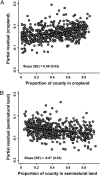Agricultural landscape simplification and insecticide use in the Midwestern United States
- PMID: 21746934
- PMCID: PMC3136260
- DOI: 10.1073/pnas.1100751108
Agricultural landscape simplification and insecticide use in the Midwestern United States
Abstract
Agronomic intensification has transformed many agricultural landscapes into expansive monocultures with little natural habitat. A pervasive concern is that such landscape simplification results in an increase in insect pest pressure, and thus an increased need for insecticides. We tested this hypothesis across a range of cropping systems in the Midwestern United States, using remotely sensed land cover data, data from a national census of farm management practices, and data from a regional crop pest monitoring network. We found that, independent of several other factors, the proportion of harvested cropland treated with insecticides increased with the proportion and patch size of cropland and decreased with the proportion of seminatural habitat in a county. We also found a positive relationship between the proportion of harvested cropland treated with insecticides and crop pest abundance, and a positive relationship between crop pest abundance and the proportion cropland in a county. These results provide broad correlative support for the hypothesized link between landscape simplification, pest pressure, and insecticide use. Using regression coefficients from our analysis, we estimate that, across the seven-state region in 2007, landscape simplification was associated with insecticide application to 1.4 million hectares and an increase in direct costs totaling between $34 and $103 million. Both the direct and indirect environmental costs of landscape simplification should be considered in design of land use policy that balances multiple ecosystem goods and services.
Conflict of interest statement
The authors declare no conflict of interest.
Figures



References
-
- Foley JA, et al. Global consequences of land use. Science. 2005;309:570–574. - PubMed
-
- Vitousek PM, Mooney HA, Lubchenco J, Melillo JM. Human domination of Earth's ecosystems. Science. 1997;277:494–499.
-
- Warner RE. Agricultural land use and grassland habitat in Illinois: Future shock for Midwestern birds? Conserv Biol. 1994;8:147–156.
-
- Robinson RA, Sutherland WJ. Post-war changes in arable farming and biodiversity in Great Britain. J Appl Ecol. 2002;39:157–176.
-
- Thies C, Steffan-Dewenter I, Tscharntke T. Effects of landscape context on herbivory and parasitism at different spatial scales. Oikos. 2003;101:18–25.
Publication types
MeSH terms
Substances
LinkOut - more resources
Full Text Sources

